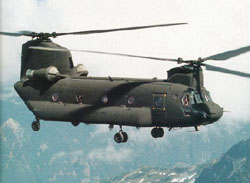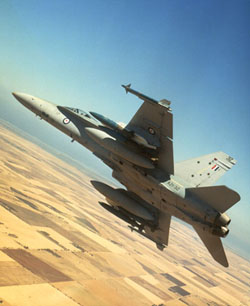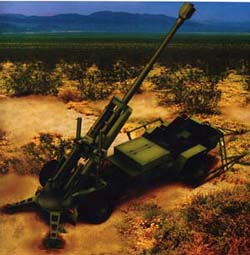Daily News
by Gail Helmer
[ Send Us News | Archives ]
First look: Xtreeme Forces
Indian game developer Raptor Entertainment is working on a 3D real-time strategy game set in the present day. The game, code-named Xtreeme Forces, is intended to be a realistic simulation of war, and it features a number of units based on real-life vehicles.
After a massive nuclear war destroys the planet, the remaining civilizations of Earth band together to form a global government called the United Colonies Front (UFC). In order to maintain control of the population, the UFC imposes strict regulations on its citizens. Players will assume control of an ordinary citizen in the society, and they can choose to join a rebel group or fight against the rebels for the UFC. Xtreeme Forces uses a 3D engine that adjusts the level of detail to match the user's system. The game is scheduled for completion in October. No official publisher or release date has been announced. We've posted some early screenshots from the game.
Global Operations Movie
Scant few days after the previous clip, another new movie of Global Operations is available to again show off Barking Dog's imminent team-based tactical shooter. This movie features a minute of gameplay from the South China Seas mission where the teams fight for control over a freighter. Download
Military News
Seven U.S. Troops Killed in Afghanistan
Seven U.S. troops were killed Monday in the deadliest battle for Americans in the Afghan conflict when two army helicopters were hit by enemy fire during a major offensive against al Qaeda and Taliban forces in the icy mountains of eastern Afghanistan.

The commander of American forces in the region also told reporters that up to 200 die-hard al Qaeda guerrillas and Taliban fighters had been killed in the first four days of U.S.-led "Operation Anaconda" near Gardez.
The U.S. Central Command said two MH-47 Army special forces helicopters were forced down by enemy ground fire on Monday and that six troops aboard one of the helicopters died, either during the hard landing or in a fierce firefight after the big aircraft landed.
RAAF F-18 Hornets To Get Radar Upgrade
The Royal Australian Air Force's fleet of F/A-18 Hornet fighters have entered the second phase of a major upgrade programme designed to improve their combat capability. The fighters, 75 of which entered service with the RAAF between 1985 and 1990, have already been fitted with improved communication and navigation systems under the first phase of the Hornet Upgrade Programme (HUG).

Now embarking on the second phase, the aircraft will receive a new advanced Fire Control radar and upgradeable flight software. Two aircraft have already been fitted with the new APG-73 radar for validation and verification purposes. The remainder of the fleet will be modified at RAAF Base Williamtown by Boeing Australia Limited.
Full production work is scheduled to start mid-year and be completed by mid-2003. The entire HUG programme costs $1.5 billion.
Personnel from the RAAF and Defence Materiel Organisation are working with Boeing, Raytheon and United States Navy personnel on the project.
Light Weight Self Propelled Howitzer - Built For Rapid Deployment
To meet the problems of providing adequate fire support to forces inserted deep in the battlefield Singapore Technologies Kinetics (ST Kinetics) is developing self propelled 155 mm calibre howitzers that can be air lifted in by tactical air transports. The new Light Weight Self Propelled Howitzer (LWSPH) is a 39 calibre 155 mm self propelled howitzer that is mounted on a light weight powered chassis and air-transported by C130s, CH47Ds and CH 53s.
Powered by a turbo-charged intercooled diesel engine, the LWSPH is mounted on a space frame chassis, enabling rapid deployment from aircraft to the battlefront.

The LWSPH has a maximum speed of 80 km/h, cruising range of 600 km and a slope-climbing capability of 60%. It is also designed for battlefield survivability with its ability to shoot and scoot. A quick dash across 500 m takes less than a minute. Emplacement and displacement, which requires only three men, also takes less than a minute.
The LWSPH is able to deliver extended range projectiles of up to 30 km.
Said Mr Wu Tzu Chien, President of ST Kinetics: "The LWSPH offers an unprecedented solution in being able to meet the rapid deployment needs of modern armed forces. We believe we have set the design standards for other howitzers of similar class."
Leading Italian weapon and automotive manufacturer, Oto Melara, is in collaboration with ST Kinetics to develop a variant for the LWSPH. The LWSPH is currently in the prototype phase. It will be ready for production in 2003.
Singapore Technologies Kinetics (ST Kinetics) is the land systems arm of Singapore Technologies Engineering (ST Engg), providing design and engineering services for military vehicles, weapon systems and munitions ranging from manufacturing, upgrading, repair to maintenance and life cycle management.
Hypersonic Missile Reaches More Than 6.5 Mach In Low-Level Flight
During a flight test at a German test site, a new design of missile developed by EADS/LFK has reached a speed of over 6.5 Mach, more than 2.1 kilometres per second, in low-level flight. The successful test was carried out as part of the Hypersonic Missile research and technology project, which the German Federal Office for Defence Technology and Procurement has commissioned.
Apart from the new engine, the aim of the test was to investigate the new aerodynamic control system. The conically-shaped high-thrust engine, which was designed by the EADS subsidiary Bayern-Chemie, confirmed its capabilities. The effectiveness of the lattice fins, which are an important part of the aerodynamic control system, has been proved fully. Evaluations of the test results have up to now shown that the prescribed roll rate of the missile has been reached. To measure this, a magnetic field sensor from the Franco-German research institute ISL was used for the first time.
"By attaining speeds which have never before been reached, our engineers have given an impressive demonstration of the technological capabilities of our company. Using the hypersonic test bed, we are able to investigate a broad variety of technical and physical phenomena in the high-speed range which will be of advantage to future applications," commented Werner Kaltenegger, CEO of EADS/LFK, on the research work.
Following the evaluation of all test results, a further flight test within the framework of the Hypersonic Missile research and technology project is due to take place in Germany before 2003.
[ Send Us News | Archives ]
by Gail Helmer
Tuesday March 05, 2002
- First look: Xtreeme Forces
- Global Operations Movie
- Seven U.S. Troops Killed in Afghanistan
- RAAF F-18 Hornets To Get Radar Upgrade
- Light Weight Self Propelled Howitzer - Built For Rapid Deployment
- Hypersonic Missile Reaches More Than 6.5 Mach In Low-Level Flight
First look: Xtreeme Forces
Indian game developer Raptor Entertainment is working on a 3D real-time strategy game set in the present day. The game, code-named Xtreeme Forces, is intended to be a realistic simulation of war, and it features a number of units based on real-life vehicles.
After a massive nuclear war destroys the planet, the remaining civilizations of Earth band together to form a global government called the United Colonies Front (UFC). In order to maintain control of the population, the UFC imposes strict regulations on its citizens. Players will assume control of an ordinary citizen in the society, and they can choose to join a rebel group or fight against the rebels for the UFC. Xtreeme Forces uses a 3D engine that adjusts the level of detail to match the user's system. The game is scheduled for completion in October. No official publisher or release date has been announced. We've posted some early screenshots from the game.
Global Operations Movie
Scant few days after the previous clip, another new movie of Global Operations is available to again show off Barking Dog's imminent team-based tactical shooter. This movie features a minute of gameplay from the South China Seas mission where the teams fight for control over a freighter. Download
Military News
Seven U.S. Troops Killed in Afghanistan
Seven U.S. troops were killed Monday in the deadliest battle for Americans in the Afghan conflict when two army helicopters were hit by enemy fire during a major offensive against al Qaeda and Taliban forces in the icy mountains of eastern Afghanistan.

The commander of American forces in the region also told reporters that up to 200 die-hard al Qaeda guerrillas and Taliban fighters had been killed in the first four days of U.S.-led "Operation Anaconda" near Gardez.
The U.S. Central Command said two MH-47 Army special forces helicopters were forced down by enemy ground fire on Monday and that six troops aboard one of the helicopters died, either during the hard landing or in a fierce firefight after the big aircraft landed.
RAAF F-18 Hornets To Get Radar Upgrade
The Royal Australian Air Force's fleet of F/A-18 Hornet fighters have entered the second phase of a major upgrade programme designed to improve their combat capability. The fighters, 75 of which entered service with the RAAF between 1985 and 1990, have already been fitted with improved communication and navigation systems under the first phase of the Hornet Upgrade Programme (HUG).

Now embarking on the second phase, the aircraft will receive a new advanced Fire Control radar and upgradeable flight software. Two aircraft have already been fitted with the new APG-73 radar for validation and verification purposes. The remainder of the fleet will be modified at RAAF Base Williamtown by Boeing Australia Limited.
Full production work is scheduled to start mid-year and be completed by mid-2003. The entire HUG programme costs $1.5 billion.
Personnel from the RAAF and Defence Materiel Organisation are working with Boeing, Raytheon and United States Navy personnel on the project.
Light Weight Self Propelled Howitzer - Built For Rapid Deployment
To meet the problems of providing adequate fire support to forces inserted deep in the battlefield Singapore Technologies Kinetics (ST Kinetics) is developing self propelled 155 mm calibre howitzers that can be air lifted in by tactical air transports. The new Light Weight Self Propelled Howitzer (LWSPH) is a 39 calibre 155 mm self propelled howitzer that is mounted on a light weight powered chassis and air-transported by C130s, CH47Ds and CH 53s.
Powered by a turbo-charged intercooled diesel engine, the LWSPH is mounted on a space frame chassis, enabling rapid deployment from aircraft to the battlefront.

The LWSPH has a maximum speed of 80 km/h, cruising range of 600 km and a slope-climbing capability of 60%. It is also designed for battlefield survivability with its ability to shoot and scoot. A quick dash across 500 m takes less than a minute. Emplacement and displacement, which requires only three men, also takes less than a minute.
The LWSPH is able to deliver extended range projectiles of up to 30 km.
Said Mr Wu Tzu Chien, President of ST Kinetics: "The LWSPH offers an unprecedented solution in being able to meet the rapid deployment needs of modern armed forces. We believe we have set the design standards for other howitzers of similar class."
Leading Italian weapon and automotive manufacturer, Oto Melara, is in collaboration with ST Kinetics to develop a variant for the LWSPH. The LWSPH is currently in the prototype phase. It will be ready for production in 2003.
Singapore Technologies Kinetics (ST Kinetics) is the land systems arm of Singapore Technologies Engineering (ST Engg), providing design and engineering services for military vehicles, weapon systems and munitions ranging from manufacturing, upgrading, repair to maintenance and life cycle management.
Hypersonic Missile Reaches More Than 6.5 Mach In Low-Level Flight
During a flight test at a German test site, a new design of missile developed by EADS/LFK has reached a speed of over 6.5 Mach, more than 2.1 kilometres per second, in low-level flight. The successful test was carried out as part of the Hypersonic Missile research and technology project, which the German Federal Office for Defence Technology and Procurement has commissioned.
Apart from the new engine, the aim of the test was to investigate the new aerodynamic control system. The conically-shaped high-thrust engine, which was designed by the EADS subsidiary Bayern-Chemie, confirmed its capabilities. The effectiveness of the lattice fins, which are an important part of the aerodynamic control system, has been proved fully. Evaluations of the test results have up to now shown that the prescribed roll rate of the missile has been reached. To measure this, a magnetic field sensor from the Franco-German research institute ISL was used for the first time.
"By attaining speeds which have never before been reached, our engineers have given an impressive demonstration of the technological capabilities of our company. Using the hypersonic test bed, we are able to investigate a broad variety of technical and physical phenomena in the high-speed range which will be of advantage to future applications," commented Werner Kaltenegger, CEO of EADS/LFK, on the research work.
Following the evaluation of all test results, a further flight test within the framework of the Hypersonic Missile research and technology project is due to take place in Germany before 2003.
